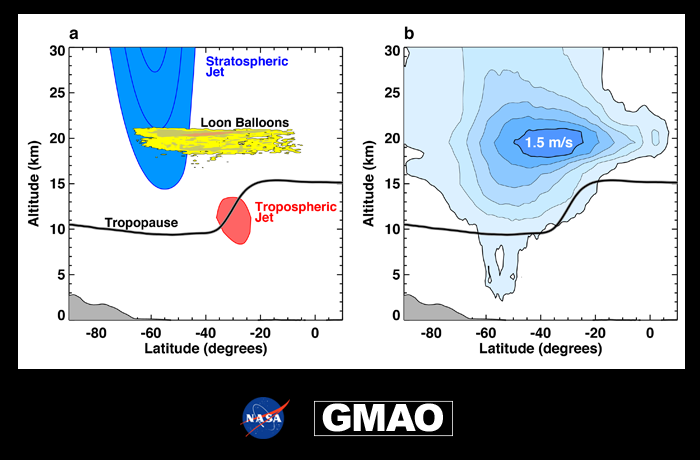Using Loon Stratospheric Balloon Observations in Global Assimilation
While satellites routinely measure Earth’s global temperatures from space, in-situ wind measurements are relatively scarce, consisting mainly of a network of ground-based weather balloons. Since only a limited number of the weather balloons reach stratospheric altitudes and since these launches are mostly over Northern Hemisphere land masses there is a need for additional stratospheric observations, especially over the Southern Hemisphere and tropical oceans. One option for additional wind information is the use of experimental super-pressure balloons (SPBs).
SPBs can remain in the stratosphere for many months traveling with the winds and hence, by reporting their changing positions, providing in-situ wind observations as they travel, including over oceans and other remote regions. These SPBs experiments are generally limited in terms of time period and number of balloons. However, over the past few years Loon has been launching hundreds of SPBs (hereafter called Loon balloons) providing a more consistent set of wind observations in the stratosphere. Since the Loon balloon focus is on providing communication links over remote regions they are often launched to cover the Southern Hemisphere and tropical oceans, precisely where traditional wind observations are lacking.
Total precipitable water is the depth of water in a column of the atmosphere, if all the water in that column were precipitated as rain.
As shown in the figures we assimilated three months (June-August 2014) of the Loon balloon winds into the NASA GEOS global data assimilation system (DAS). The DAS combines all observations with an atmospheric model to produce global analysis of winds and temperatures. Figure 1 highlights changes in the August DAS wind analysis when the Loon balloons are added to the assimilation. Figure 1a shows the location of the August 2014 Loon observations relative to the stratospheric and tropospheric jet streams. These Loon balloons move with the strong August stratospheric east-west winds providing global coverage from 10S-60N. Figure 1b shows the root mean squared zonal (east-west) wind differences between the DAS run with and without the Loon balloons. The largest changes occur at the level of the Loon balloons, however the DAS spreads the observations so that some analysis changes are found throughout a much broader region, with some hints of change even in the troposphere.
Additional results in the paper illustrated the Loon balloon's capability to provide significant improvements in the tropical wind analyses. Along with improved wind analyses, adding the Loon balloons to the DAS improved the system's forecast of the Loon balloon's position. These results provide direction to future model and analysis improvements.
Reference:
Coy, L., M.R. Schoeberl, S. Pawson, S. Candido, and R.W. Carver, 2019: Global assimilation of Loon stratospheric balloon observations.J. Geophys. Res.: Atmos, 124. https://doi.org/10.1029/2018JD029673


